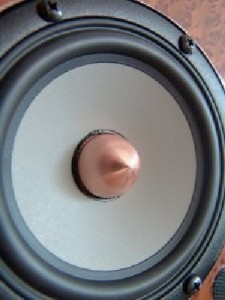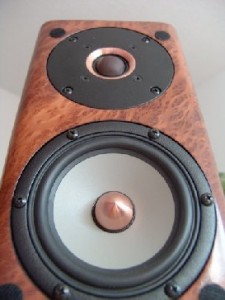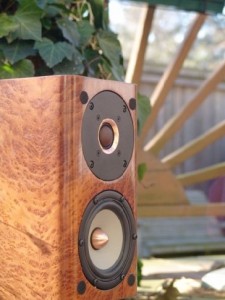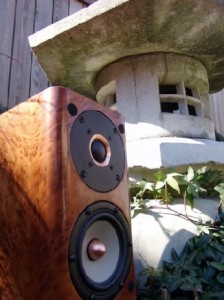- Source: Naim CD5i; E-MU 1212M
- Integrated amplifier: Naim Nait5i; Harman Kardon 3470
- Amplifier: Marsh A200s
- Cables: 6mTributaries 16awg speaker cables; DIY
- interconnects w/Eichmann Bullet Plugs
- Stand: Custom Oak stand
- Room size: 11xW, 9xD, 8xH
- Review Component Price: $1,200.00 USD with standard veneers
Anymore, a one-man start-up hi-fi business has become as common as a mosquito in mid summer. A simple trot through the virtual markets will unearth what seems to be an endless supply of amplifiers, speakers, DAC’s, product modifications, and tweaks. Heck, you can buy a pair of magic pebbles in a jar if it makes you happy. With such an overwhelming abundance of this and that on the market, sometimes it may feel that the only way to escape is to simply unplug.
Now, don’t get me wrong; I take my hat off to anyone who posses both the talent and desire to put their design on the market for all to judge. As someone who has never personally done so, it’s hard to caste stones without having a few thrown my way. While I do my best to insure I give fair criticism, I am unafraid to admit a personal bias. I seek products that have a sense of innovation about them, something that has never been done before in one way or another, vice the typical re-fitted interpretation of a proven design that’s been done countless times over. Yet in this day and age of e-commerce, that’s the oar we all must row with together.
So then the question becomes; where does ho hum hi-fi end and the real interesting stuff begin? It’s a question that spawns many different and personal answers, but for yours truly, ‘interesting stuff’ is something that breathes new life, its something refreshing. So where does Tyler Acoustics fit into the picture? Read on.
Tyler Linbrook Mini review
Integrity, Honesty, Passion
In Owensboro, Kentucky, you’ll find a shining example of a simple southern audiophile that turned his love for music and electronics into a full-time speaker business. That man is Ty Lashbrook, founder and present day owner of Tyler Acoustics. Although he has been in business for nearly ten years, you will not find Tyler Acoustic speakers on a dealer show-room floor anywhere on this planet. Un- less you happen across one of his customers, you will have to do what everyone must do to get plugged in; go online. The virtual world is the turf Ty plays in, advertising strictly by means of classifieds in Audiogon and word of mouth sales.
So what’s so special about Tyler Acoustics? What makes this particular company stand out among other online competitors? Almost anyone can figure it out after just a phone call; it’s the man himself. Nearly always accessible, Ty is an unashamed blue jeans a t-shirt kinda’ guy. You won’t find him wearing a pseudoclassy businessman exterior with a slight tilt of the nose to the air telling you why his wine is the superior drink. Instead, he’s the kind of guy who’d crack open a cold one with you and talk shop. For Ty, it’s all about having a good time and allowing others to join in by giving them the opportunity to enjoy a slice of true hi-fi at blue collar prices. Still, being nice and having friends won’t pay the bills and keep the doors open. You’ve gotta’ make the goods people want, and you gotta’ make em’ deliver. If you’ve read any customer testimonials on the web, than you know Ty must have something good going on in that department. At first opportunity, I asked Ty:
“So what’s the magic mojo behind your highly regarded speakers?”
“Well…….none”
That’s right. Nada. Zip. There is no innovative recipe behind a Tyler Acoustics speaker. No new technology and no new concepts. Instead of focusing on the cutting edge, Ty uses the old fashioned “tried and true” approach. In this case, that means taking the best cost-effective parts you can get your hands on, design a solid network around them, tweak that design until satisfied, and then top it off by offering that design in a sturdy, well made cabinet wrapped in a wide variety of real wood veneers. While there is nothing new going on behind the scenes at Tyler Acoustics, you are sure to get a speaker of extremely high quality designed and hand built on US shores in the good state of Kentucky. Wrap it all in a complete package with the three words heading this column and that folks, is refreshing enough for me.
The Baby Linbrook
Like many audiophiles, space is hardly a premium at casa del Sean. So you make do with what you have, which in my case means running either monitors or small towers. Since our own Brad Mitchell evaluated a pair of Taylo Reference Monitors, one of Tyler Acoustics most popular models, I decided to bring in the little reviewed baby Linbrook, otherwise officially known as the Linbrook Super Mini.
Ty, a man who’s personal speakers sport two 18” woofers, two 10” mid woofers with a ribbon tweeter is unafraid to admit that he believes in the old adage of there being no replacement for displacement. In other words; “bigger is often better, or at the very least is more fun”. Far be it from me or many audiophiles to bring home such a monster. That’s the stuff daydreams are made of. By sharp contrast, the Super Mini was born to fulfill one purpose; to give people marred by room constraints a high performance mini monitor worthy of Linbrook lineage in an ultra compact and affordable package.
First Impressions and Set Up
As much as I love good hi-fi and a good story, I also love a good laugh. This is exactly what I got when I ‘hefted’ the super minis from their shipping carton. Measuring only 6”w x 6d” x 10.5h” and weighing in at a whopping 12lbs, these solid yet laughably small monitors could easily dub as a brick shaped football to a curious youngster.
All jokes aside, the super minis are clearly built to deliver the hi-fi goods. Armed with the very expensive Sea’s 1” Excel Millennium tweeter with a complimenting 4.5” Sea’s Excel magnesium woofer, you’ll be hard pressed to find any speaker near its size and price that can boast of carrying dynamic drivers of such pedigree. With a simple 8 ohm nominal load working at 88db efficiency, even lovers of low powered valves should encounter few hassles running the minis. Despite their size, the super mini is rated as delivering solid frequency extension from 60hz to 25khz.
With all of that said, the first thing that anyone will notice is a speaker’s aesthetics. My pair, wrapped in redwood burl, matched the copper phase plugs in the Sea’s drivers to the point to where I caught myself just staring and admiring the beautiful visual synergy. The combination made for both a very elegant and dramatic statement, albeit in mini size. If red wood burl is not your bag, Ty has a plethora of other fine veneers to choose from. Offering a tiny footprint with beautiful looks, the super mini is a sure-fire win for your better half. Whipped lovers, rejoice! Unfortunately I must give Ty 10 demerits for the application of velcro for the speaker grills, marking what is otherwise excellent craftsmanship.
The system used for product evaluation consisted of the Naim Nait 5i integrated amplifier and the matching Naim CD5i cd-player. Alternatively, I also used a Marsh A200s amplifier ran direct from my PC using a bone-stock E-MU 1212M sound-card. I ended up preferring the later by no small margin and decided to stick with that particular combo throughout my evaluation. I used Foobar2K for music playback software and set up shop in my small 11×9 space.
The Mini Linbrook Sound – The Good
While the baby linbrook is mini in size, its sound is as open, rich, and as clean as its big brothers; reminding you that it’s still a Linbrook in every respect. Like most mini monitors, you can expect to encounter incredibly wide and pin-point imaging that can virtually disappear within the sonic landscape, essentially becoming invisible to the ear; allowing the music to take center stage. Ready and armed with a wide variety of both audiophile and non audiophile approved music, I sat down in hard-core evaluation mode only to find myself distracted once again. No, it wasn’t the planes rushing overhead, the neighborhood dogs barking or my own dogs howling to complete the harmony. It was just the usual hurdle I had to overcome whenever I encounter a speaker can deliver good musical mojo. For a listener, that’s a good thing – for someone whose job it is to focus on dissecting a products performance, it can quickly become a pleasant misery. Nary a few times where I felt taking the easy way out by boasting a simple headline reading; “All you need to know is that its good – try it for yourself” Ah, if only life were that simple.
The most salient attribute of the Mini Linbrook is their even-keeled neutrality that never comes across as harsh, thin, warm, or clinical. The previously reviewed ACI Sapphire XL for example, tend to have warm sound to them complemented with a soft top end and a blossomed mid-range. The SIA Rothschilde A2’s by contrast err more to the side of being exceptionally fast and coherent, if not a bit aggressive on the top end. The Mini Linbrooks character rests comfortably between the two extremes, rendering a sound that never draws your ear towards any particular aspect of their performance. The only time I encountered a very distinct color in presentation came whenever I matched them with high-powered solid state electronics. The resulting match nudged their signature more to towards the forward side of neutral. Otherwise, balance is the name of the Linbrook game.
The ability of the super mini to keep each individual musical instrument and vocalist distinct from one another took me by pleasant surprise. It is not too uncommon for even very expensive and high quality compact speakers to suffer congestion when they are asked to deliver a lot of musical content at once. We’ve all experienced it at one time or another; you are sitting down enjoying a pair of speakers and everything seems just great, that is, until the music hits a crescendo and all the instruments mutate into a loud and indistinct sonic mass. Even the big towers of power can suffer the same drawbacks. These ultra compact monitors managed to handle those passages with aplomb, not only remaining free of electronic interference, but doing so without damning compromise to their strengths of soundstage depth and timbre.
This leads me to my own most critical aspect of a loudspeaker; tone. A speaker can have all the wonderful audiophile attributes; it could image well, it could be dynamic, detailed, balanced, holographic and fast, but if it ultimately sounds like a reproduced electrical signal and not an instrument – I’m not interested. In fact, let me just cut to the chase here; short of a few speakers from Totem Acoustic, these tiny monitors produced some of the most authentic and convincing tone I’ve heard under the 2k mark. This to include a handful of famous monitors I’ve owned in recent history; the Spendor SP 3/1P’s, the Dynaudio Focus 110’s, and the ACI Sapphire XL’s. While I have immense respect for all of the aforementioned speakers, the Tyler’s are able to reproduce the spirit of strings, piano, guitar, and woodwind like none of them can. There is a fundamental difference between reproduction that sounds ‘nice’ to something that sounds ‘real’. Real is an open-ended term of course, and I want to clarify that you should not expect to hear a stringed quartet in your living room with these speakers. That’s just wishful thinking! Instead, you can at the very least bank on gaining an insight into the tone of each instrument. Within most un-amplified music there are physical properties and mechanical personalities that engage our senses and trigger a personal emotional response. It is natural. It is engaging. It’s the musical experience. I have encountered few affordable speakers capable of such insight. The baby Linbrooks, small though as they may be, crack open the door into that wonderful world of discovery and experience.
The Mini Linbrook Sound – The Compromise
While this review has read nothing short of a rave, keen and experienced readers will note that I’ve left out one very critical aspect of the speakers performance; their bass response. While I contemplated matching the Mini Linbrook with a capable compact sub like the REL Q108, I decided to evaluate the speaker based off the merits of their own design without introducing bottom end reinforcement. After all, I am not here to review how they sound as a complete package. I am here to tell you what they can and cannot do all by their lonesome.
Ty specs the super mini as digging down to 60hz, a number I quickly found to be very generous, if not bordering on over-stated. Despite my efforts to use room gain to up their output, I failed to achieve anything that remotely could be called authority below the 80hz point. In other words; they just won’t rock and roll, at least not by themselves. While the bass the mini Linbrooks produce is lightning fast – it may leave most music lovers wanting for a bit more down low.
Unfortunately, the compromise of small size does not end at bass response. You also will sacrifice the ability of a speaker to play cleanly at high volumes, or in other words; loudness capability. The Ty’s can dish out some pretty good volume – up to a point. At around 88-90db I encountered audible port-noise in conjunction with a shouty mid-range. While stuffing the ports with a nice foam plug helped to subdue the side-effects of high output, it came at the expense of even less low end authority. This effectively killed some of their ‘magic’ and made the speaker sound as small as they truly are.
This report should not come as a surprise to anyone. While many great things have been accomplished in the world of electronics, we are all still bound by the laws of physics as we know them. If you happen to be one of those audiophiles that listen to primarily baroque and acoustic guitar, than disregard all of the above in this column. For the rest of you looking to gain a full performance, the odds are likely that a sub will be in your future. Therein lies another problem; good compact subwoofers that can match the speed of the Tyler’s in the 80hz range are hard to come by, and can get pricey –bringing the total cost of your speakers dangerously close to the $2000 mark. Thankfully there are options out there, and when it comes to musical bass – I will begin knocking at the door of REL, Mj Acoustics, Onix and ACI. The bottom line is that if you have a few more dollars and inches to spare, you maybe better served by moving up to the Tyler Taylo Reference monitor. However, if you are stuck and want a killer pair of ultra compact monitors – you’ve reached the top of the mountain.
CONCLUSION
In the end, what the Tyler Acoustics Super Mini Linbrook falls short on is more than compensated by their extraordinary ability to deliver on where it counts the most; the musical goods. The Sea’s Excel Millennium is the star of the show, delivering texture and delicacy I’ve never before heard in a soft dome tweeter. Their neutrality, imaging and low level resolution are also amongst the best I’ve heard in their range. Taking into consideration their Kentucky heritage, exceptional build quality, parts quality that defies anything their price tag, alluring sound quality topped by first class customer service by the man himself, I know of no other speaker on this planet that can challenge the Mini at its own game. If you happen to find a product that can, let me know, as that would be a story worth telling. Meanwhile, take a bow Mr. Lashbrook – you’ve earned it.
 from affordableaudio, By Sean Fowler
from affordableaudio, By Sean Fowler




